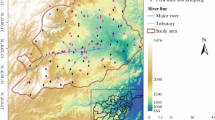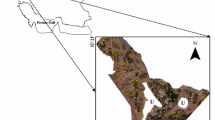Abstract
Conventional soil maps generally depict information about soil spatial distribution in the framework of crisp boundaries of tessellated soil polygons. Such maps in standard soil survey procedures determine map unit composition on the basis of relative acreage occupied by individual major and minor soil components within soil map unit without addressing the specific location of each component in the polygon boundary. These limitations in addition to the sharp-edge boundaries of conventional soil maps are considered obstacles for modern land resource management. To increase detail in the polygon of conventional soil maps, we have produced a spatially disaggregated soil class map of a relatively flat agricultural plain called Saadat Shahr in South-Central Iran, using DSMART algorithm. DSMART is a known DSM-based disaggregation and harmonization algorithm that works through resampled classification trees to estimate the probability of the existence of each possible soil classes and also to prepare the maps of the most probable soil class, second most probable, and so on in raster format. The conventional soil map and 124 georeferenced profiles, as well as a set of numerical and categorical auxiliary data in 10-m resolutions in the extent of the study area utilized as the SCORPAN variables, were used as the inputs of the DSMART algorithm. A set of 78 independent sampling points generated by Latin hypercube sampling scheme were investigated and then used for validation of the DSMART raster outputs. The results indicated an improvement in disaggregated maps in the case of allocating soil components within the map units. In the generated DSMART, overall accuracy for seven soil subgroups was 68%. The best prediction obtained for Typic Xerorthents and Typic Calcixerepts, meanwhile a few classes were poorly predicted. For second most probable and third most probable maps, 17% and 0.5% of predicted soils match that observed respectively. This study revealed that DSMART as a disaggregation method can be used for enhancing existence soil map with poor descriptive data in the case of allocating soil classes in a more detailed way compared to the relevant original map.





Similar content being viewed by others
Change history
16 April 2021
A Correction to this paper has been published: https://doi.org/10.1007/s10661-021-08984-5
References
Arrouays, D., McKenzie, N., de Forges, A. R., Hempel, J., & McBratney, A. B. (2014). Global Soil Map: basis of the global spatial soil information system. Boca Raton: CRC Press.
Brungard, C. W., Boettinger, J. L., Duniway, M. C., Wills, S. A., & Edwards Jr., T. C. (2015). Machine learning for predicting soil classes in three semi-arid landscapes. Geoderma, 239, 68–83.
Bui, E. N., & Moran, C. J. (2001). Disaggregation of polygons of surficial geology and soil maps using spatial modelling and legacy data. Geoderma, 103(1-2), 79–94.
Bui, E. N., Loughhead, A., & Corner, R. (1999). Extracting soil-landscape rules from previous soil surveys. Soil Research, 37(3), 495–508.
Burrough, P. A., van Gaans, P. F., & Hootsmans, R. (1997). Continuous classification in soil survey: spatial correlation, confusion and boundaries. Geoderma, 77(2-4), 115–135.
Chaney, N., Hempel, J. W., Odgers, N.P., McBratney, A. B., & Wood, E. F. (2014). Spatial disaggregation and harmonization of gSSURGO. In ASA, CSSA and SSSA international annual meeting, Long Beach. ASA, CSSA and SSSA.
Ditzler, C., Scheffe, K., & Monger, H. C. (2017). Soil Survey Manual, USDA Handbook 18, Soil Science Division Staff.
Ellili, Y., Walterb, C., Michotb, D., Sabyc, N., Vincenta, S., & Lemercierb, B. (2019). Validation of digital maps derived from spatial disaggregation of legacy soil maps. Geoderma, 365, 113907.
Emberger, L. (1963). Bioclimatic map of the Mediterranean zone: explanatory notes (Vol. 21). UNESCO-FAO.
Gallant, J. C., & Austin, J. M. (2015). Derivation of terrain covariates for digital soil mapping in Australia. Soil Research, 53(8), 895–906.
Gallant, J. C., & Dowling, T. I. (2003). A multiresolution index of valley bottom flatness for mapping depositional areas. Water Resources Research, 39(12), 1347–1360.
Gallant, J. P., & Wilson, J. C. (2000). Terrain analysis: principles and applications. Hoboken: Wiley.
Grunwald, S. (2010). Current state of digital soil mapping and what is next. In Digital Soil Mapping (pp. 3–12). Dordrecht: Springer.
Hansen, M. K., Brown, D. J., Dennison, P. E., Graves, S. A., & Bricklemyer, R. S. (2009). Inductively mapping expert-derived soil-landscape units within dambo wetland catenae using multispectral and topographic data. Geoderma, 150(1-2), 72–84.
Häring, T., Dietz, E., Osenstetter, S., Koschitzki, T., & Schröder, B. (2012). Spatial disaggregation of complex soil map units: A decision-tree based approach in Bavarian forest soils. Geoderma, 185, 37–47.
Hassanshahi, H. (1991). Semi detailed soil survey of Saadat Shar, Seidan, Sivand and Arsenjan plains in Fars Province. Tehran: Soil and Water Research Institute of Iran. No: 838 115 p. (In Persian).
Hengl, T. (2009). A practical guide to geostatistical mapping (Vol. 52). Amsterdam: Office for Official Publications of the European Communities.
Heung, B., Ho, H. C., Zhang, J., Knudby, A., Bulmer, C. E., & Schmidt, M. G. (2016). An overview and comparison of machine-learning techniques for classification purposes in digital soil mapping. Geoderma, 265, 62–77.
Holmes, K. W., Odgers, N. P., Griffin, E. A., & van Gool, D. (2014). Spatial disaggregation of conventional soil mapping across Western Australia using DSMART. Global Soil Map: Basis of the global spatial soil information system. London: Taylor& Francis, 273–279.
Kempen, B., Brus, D. J., Heuvelink, G. B., & Stoorvogel, J. J. (2009). Updating the 1: 50,000 Dutch soil map using legacy soil data: A multinomial logistic regression approach. Geoderma, 151(3-4), 311–326.
Kerry, R., Goovaerts, P., Rawlins, B. G., & Marchant, B. P. (2012). Disaggregation of legacy soil data using area to point kriging for mapping soil organic carbon at the regional scale. Geoderma, 170, 347–358.
Lagacherie, P., Arrouays, D., & Walter, C. (2013). Cartographie numérique des sols: Principe, mise en œuvre et potentialités. Etude et Gestion des Sols, 20(1), 83–98.
MacMillan, R. A., Moon, D. E., & Coupé, R. A. (2007). Automated predictive ecological mapping in a forest region of BC, Canada, 2001–2005. Geoderma, 140(4), 353–373.
Mahler, P. J. (1970). Manual of multipurpose land classification, Report no. 212. Tehran: Soil and Water Research Institute.
Malone, B. P., Minasny, B., & McBratney, A. B. (2017). Using digital soil mapping to update, harmonize and disaggregate legacy soil maps. In Using R for Digital Soil Mapping (pp. 221–230). Cham: Springer.
McBratney, A. B. (1998). Some considerations on methods for spatially aggregating and disaggregating soil information. In Soil and water quality at different scales (pp. 51–62). Dordrecht: Springer.
McBratney, A. B., Santos, M. M., & Minasny, B. (2003). On digital soil mapping. Geoderma, 117(1-2), 3–52.
Miller, B. A., Koszinski, S., Wehrhan, M., & Sommer, M. (2015). Impact of multi-scale predictor selection for modeling soil properties. Geoderma, 239, 97–106.
Minasny, B., & McBratney, A. B. (2006). A conditioned Latin hypercube method for sampling in the presence of ancillary information. Computers & Geosciences, 32(9), 1378–1388.
Minasny, B., McBratney, A. B., Malone, B. P., & Wheeler, I. (2013). Digital mapping of soil carbon. In Advances in Agronomy 118, 1–47.
Mirakzehi, K., Pahlavan-Rad, M. R., Shahriari, A., & Bameri, A. (2018). Digital soil mapping of deltaic soils: A case of study from Hirmand (Helmand) river delta. Geoderma, 313, 233–240.
Moller, A. B., Malone, B., Odgers, N. P., Beucher, A., Iversen, B. V., Greve, M. H., & Minasny, B. (2019). Improved disaggregation of conventional soil maps. Geoderma, 341, 148–160.
Moore, I. D., Grayson, R. B., & Ladson, A. R. (1991). Digital terrain modelling: a review of hydrological, geomorphological, and biological applications. Hydrological Processes, 5(1), 3–30.
Mosleh, Z., Salehi, M. H., Jafari, A., Borujeni, I. E., & Mehnatkesh, A. (2016). The effectiveness of digital soil mapping to predict soil properties over low-relief areas. Environmental Monitoring and Assessment, 188(3), 195.
National Cartographic Center of Iran. (1998). 1:25,000 digital topographic maps, Tehran, Iran. http://www.ngdir.ir/. Accessed 1998.
Nauman, T. W., & Thompson, J. A. (2014). Semi-automated disaggregation of conventional soil maps using knowledge driven data mining and classification trees. Geoderma, 213, 385–399.
Odgers, N. P., Sun, W., McBratney, A. B., Minasny, B., & Clifford, D. (2014). Disaggregating and harmonising soil map units through resampled classification trees. Geoderma, 214, 91–100.
Odgers, N. P., McBratney, A. B., & Minasny, B. (2015). Digital soil property mapping and uncertainty estimation using soil class probability rasters. Geoderma, 237, 190–198.
Pahlavan-Rad, M. R., & Akbarimoghadam, A. (2018). Spatial variability of soil texture fractions and pH in a flood plain (case study from eastern Iran). Catena, 160, 275–281.
Qi, J., Kerr, Y., & Chehbouni, A. (1994). External factor consideration in vegetation index development. Proc. of Physical Measurements and Signatures in Remote Sensing, ISPRS, 723-730.
Quinlan‚ J. R. (2003). C5.0 Online Tutorial. Quinlan‚ J. R. C5.0 Online Tutorial. https://www.rulequest.com.
R Development Core Team. (2012). R: A language and environment for statistical computing. Vienna: R Foundation for Statistical Computing Internet: http://www.R-project.org. Accessed 2012.
Rudiyanto Minasny, B., Setiawan, B. I., Arif, C., Saptomo, S. K., & Chadirin, Y. (2016). Digital mapping for cost-effective and accurate prediction of the depth and carbon stocks in Indonesian peatlands. Geoderma, 117(1–2), 3–52.
SAGA, G, 2013. System for automated geoscientific analyses. Available at: www.saga-gis.org/en/index.html. Accessed 2013.
Sarmento, E. C., Giasson, E., Weber, E. J., Flores, C. A., & Hasenack, H. (2017). Disaggregating conventional soil maps with limited descriptive data: A knowledge-based approach in Serra Gaúcha, Brazil. Geoderma Regional, 8, 12–23.
Scull, P., Okin, G., Chadwick, O. A., & Franklin, J. (2005). A comparison of methods to predict soil surface texture in an alluvial basin. The Professional Geographer, 57(3), 423–437.
Segl, K., Guanter, L., Gascon, F., Kuester, T., Rogass, C., & Mielke, C. (2015). S2eteS: An end-to-end modeling tool for the simulation of Sentinel-2 image products. IEEE Transactions on Geoscience and Remote Sensing, 53(10), 5560–5571.
Soil Survey Staff. (2014). Keys to Soil Taxonomy (12th ed.). Washington DC: USDA-Natural Resources Conservation Service.
Story, M., & Congalton, R. G. (1986). Accuracy assessment: a user’s perspective. Photogrammetric Engineering and Remote Sensing, 52(3), 397–399.
Subburayalu, S. K., Jenhani, I., & Slater, B. K. (2014). Disaggregation of component soil series on an Ohio County soil survey map using possibilistic decision trees. Geoderma, 213, 334–345.
Taghizadeh-Mehrjardi, R., Nabiollahi, K., Minasny, B., & Triantafilis, J. (2015). Comparing data mining classifiers to predict spatial distribution of USDA-family soil groups in Baneh region, Iran. Geoderma, 253, 67–77.
Teng, H., Rossel, R. A. V., Shi, Z., & Behrens, T. (2018). Updating a national soil classification with spectroscopic predictions and digital soil mapping. Catena, 164, 125–134.
Tucker, C. J. (1979). Red and photographic infrared linear combinations for monitoring vegetation. Remote Sensing of Environment, 8(2), 127–150.
Vincent, S., Lemercier, B., Berthier, L., & Walter, C. (2018). Spatial disaggregation of complex soil map units at the regional scale based on soil-landscape relationships. Geoderma, 311, 130–142.
Wei, S., McBratney, A., Hempel, J., Minasny, B., Malone, B., D’Avello, T., Burras, L., & Thompson, J. (2010). Digital harmonisation of adjacent analogue soil survey areas–4 Iowa counties. In Proceedings World Congress of Soil Science: Soil solutions for a changing world, 19th, Brisbane, Australia (pp. 1–6).
Yang, L., Jiao, Y., Fahmy, S., Zhu, A., Hann, S., Burt, J. E., & Qi, F. (2011). Updating conventional soil maps through digital soil mapping. Soil Science Society of America Journal, 75(3), 1044–1053.
Acknowledgments
The authors gratefully thank the support of the University of Zanjan (ZNU).
Author information
Authors and Affiliations
Corresponding author
Additional information
Publisher’s note
Springer Nature remains neutral with regard to jurisdictional claims in published maps and institutional affiliations.
The original online version of this article was revised: Due to error in the name of the third author.
Rights and permissions
About this article
Cite this article
Jamshidi, M., Delavar, M.A., Taghizadehe-Mehrjardi, R. et al. Disaggregation of conventional soil map by generating multi realizations of soil class distribution (case study: Saadat Shahr plain, Iran). Environ Monit Assess 191, 769 (2019). https://doi.org/10.1007/s10661-019-7942-x
Received:
Accepted:
Published:
DOI: https://doi.org/10.1007/s10661-019-7942-x




